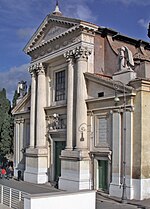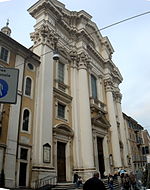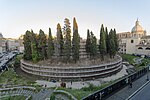Palazzo Borghese

Palazzo Borghese is a palace in Rome, Italy, the main seat of the Borghese family. It was nicknamed il Cembalo ("the harpsichord") due to its unusual trapezoidal groundplan; its narrowest facade faces the River Tiber. The entrance at the opposite end of the building, the "keyboard" of the cembalo, faces onto the Fontanella di Borghese, with another in a great flanking facade to the Piazza Borghese that is extended by a slightly angled facade leading down Via Borghese towards the river. Both these entrances lead into a large courtyard on one side of which is a two level open arcade, with paired Doric and Ionic columns, that frames the garden beyond. The first floor of the palace is the seat of the Embassy of Spain in Italy since 1947.
Excerpt from the Wikipedia article Palazzo Borghese (License: CC BY-SA 3.0, Authors, Images).Palazzo Borghese
Piazza Borghese, Rome Municipio Roma I
Geographical coordinates (GPS) Address Nearby Places Show on map
Geographical coordinates (GPS)
| Latitude | Longitude |
|---|---|
| N 41.903888888889 ° | E 12.476388888889 ° |
Address
Piazza Borghese
Piazza Borghese
Rome, Municipio Roma I
Lazio, Italy
Open on Google Maps











